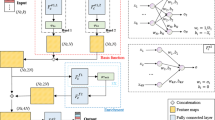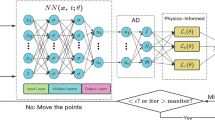Abstract
We present a comparative study of two finite element shallow water equation (SWE) models: a generalized wave continuity equation based continuous Galerkin (CG) model—an approach used by several existing SWE models—and a recently developed discontinuous Galerkin (DG) model. While DG methods are known to possess a number of favorable properties, such as local mass conservation, one commonly cited disadvantage is the larger number of degrees of freedom associated with the methods, which naturally translates into a greater computational cost compared to CG methods. However, in a series of numerical tests, we demonstrate that the DG SWE model is generally more efficient than the CG model (i) in terms of achieving a specified error level for a given computational cost and (ii) on large-scale parallel machines because of the inherently local structure of the method. Both models are verified on a series of analytic test cases and validated on a field-scale application.
Similar content being viewed by others
References
Aizinger, V., Dawson, C.: A discontinuous Galerkin method for two-dimensional flow and transport in shallow water. Adv. Water Resour. 25, 67–84 (2002)
Atkinson, J.H., Westerink, J.J., Luettich, R.A.: Two-dimensional dispersion analyses of finite element approximations to the shallow water equations. Int. J. Numer. Methods Fluids 45, 715–749 (2004)
Bey, K.S., Patra, A., Oden, J.T.: hp-version discontinuous Galerkin methods for hyperbolic conservation laws—a parallel adaptive strategy. Int. J. Numer. Methods Eng. 38, 3889–3908 (1995)
Biswas, R., Devine, K.D., Flaherty, J.E.: Parallel, adaptive finite element methods for conservation laws. Appl. Numer. Math. 14, 255–283 (1994)
Blain, C.A., Massey, T.C.: Application of a coupled discontinuous–continuous Galerkin finite element shallow water model to coastal ocean dynamics. Ocean Model. 10, 283–315 (2005)
Buffa, A., Hughes, T.J.R., Sangalli, G.: Analysis of a multiscale discontinuous galerkin method for convection-diffusion problems. SIAM J. Numer. Anal. 44, 1420–1440 (2006)
Dawson, C., Sun, S., Wheeler, M.F.: Compatible algorithms for coupled flow and transport. Comput. Methods Appl. Mech. Eng. 193, 2565–2580 (2004)
Dawson, C., Westerink, J.J., Feyen, J.C., Pothina, D.: Continuous, discontinuous and coupled discontinuous–continuous Galerkin finite element methods for the shallow water equations. Int. J. Numer. Methods Fluids 52, 63–88 (2006)
Eskilsson, C., Sherwin, S.J.: A triangular spectral/hp discontinuous Galerkin method for modelling 2D shallow water equations. Int. J. Numer. Methods Fluids 45, 605–623 (2004)
Foreman, M.G.G.: A comparison of tidal models for the southwest coast of Vancouver Island. In: Celia, M. (ed.) Computational Methods in Water Resources: Proceedings of the VII International Conference. Elsevier, Amsterdam (1988)
Gray, W.G.: A finite element study of tidal flow data for the North Sea and English Channel. Adv. Water Resour. 12, 143–154 (1989)
Gray, W.G., Lynch, D.R.: Time–stepping schemes for finite element tidal model computations. Adv. Water Resour. 1, 83–95 (1977)
Hughes, T.J.R., Scovazzi, G., Bochev, P.B., Buffa, A.: A multiscale discontinuous Galerkin method with the computational structure of a continuous Galerkin method. Comput. Methods Appl. Mech. Eng. 195, 2761–2787 (2006)
Kinnmark, I.P.E.: The Shallow Water Wave Equations: Formulations, Analysis and Application. Lecture Notes in Engineering, vol. 15. Springer, Berlin (1986)
Kolar, R.L., Westerink, J.J., Cantekin, M.E., Blain, C.A.: Aspects of nonlinear simulations using shallow-water models based on the wave continuity equation. Comput. Fluids 23, 523–528 (1994)
Kolar, R.L., Gray, W.G., Westerink, J.J.: Boundary conditions in shallow water models–an alternative implementation for finite element codes. Int. J. Numer. Methods Fluids 22, 603–618 (1996)
Kubatko, E.J., Westerink, J.J., Dawson, C.: hp discontinuous Galerkin methods for advection dominated problems in shallow water flow. Comput. Methods Appl. Mech. Eng. 196, 437–451 (2006)
Karypis, G., Kumar, V.: metis: A Software Package for Partitioning Unstructured Graphs, Partitioning Meshes, and Computing Fill-Reducing Orderings of Sparse Matrices. University of Minnesota Department of Computer Science/Army HPC Research Center, Minneapolis (1998)
Le Provost, C., Vincent, P.: Finite element for modeling ocean tides. In: Parker, B. (ed.) Tidal Hydrodynamics, pp. 41–60. Wiley, New York (1991)
Le Roux, D.Y., Lin, C.A., Staniforth, A.: A semi-implicit semi-Lagrangian finite-element shallow-water ocean model. Mon. Weather Rev. 128, 1384–1401 (2000)
Li, H., Liu, R.: The discontinuous Galerkin finite element method for the 2D shallow water equations. Math. Comput. Simul. 56, 223–233 (2001)
Luettich, R.A., Westerink, J.J., Scheffner, N.W.: ADCIRC: An advanced three-dimensional circulation model for shelves, coasts and estuaries, Report 1: Theory and methodology of ADCIRC-2DDI and ADCIRC-3DL. In: Dredging Research Program Technical Report DRP-92-6, US Army Engineers Waterways Experiment Station, Vicksburg, MS (1992)
Lynch, D.R., Gray, W.G.: Analytic solutions for computer flow model testing. J. Hydraul. Div. 104, 1409–1428 (1978)
Lynch, D.R., Gray, W.G.: A wave equation model for finite element tidal computations. Comput. Fluids 7, 207–228 (1979)
Lynch, D.R., Werner, F.E., Molines, J.M., Fornerino, M.: Tidal dynamics in a coupled ocean/lake system. Estuar. Coast. Shelf Sci. 31, 319–343 (1990)
Mukai, A.Y., Westerink, J.J., Luettich, R.A., Mark, D.: Eastcoast 2001, a tidal constituent database for Western North Atlantic, Gulf of Mexico, and Caribbean Sea. TR ERDC 01-x, US Army Engineer, Engineer Research and Development Center, Vicksburg, MS (2001)
National Oceanic and Atmospheric Administration: Tides and currents database. Online, available: http://tidesandcurrents.noaa.gov/
Schwanenberg, D., Kiem, R., Kongeter, J.: Discontinuous Galerkin method for the shallow water equations. In: Cockburn, B., Karniadakis, G.E., Shu, C.-W. (eds.) Discontinuous Galerkin Methods, pp. 289–309. Springer, Heidelberg (2000)
Walters, R.A.: A model for tides and currents in the English Channel and southern North Sea. Adv. Water Resour. 10, 138–148 (1987)
Werner, F.E., Lynch, D.R.: Harmonic structure of English Channel/Southern Bight tides from a wave equation simulation. Adv. Water Resour. 12, 121–142 (1989)
Westerink, J.J., Luettich, R.A., Baptista, A.M., Scheffner, N.W., Farrar, P.: Tide and storm surge predictions in the Gulf of Mexico using a wave-continuity equation finite element model. In: Spaulding, M.L. (ed.) Estuarine and Coastal Modeling: Proceedings of the 2nd International Conference. American Society of Civil Engineers, New York (1992)
Author information
Authors and Affiliations
Corresponding author
Rights and permissions
About this article
Cite this article
Kubatko, E.J., Bunya, S., Dawson, C. et al. A Performance Comparison of Continuous and Discontinuous Finite Element Shallow Water Models. J Sci Comput 40, 315–339 (2009). https://doi.org/10.1007/s10915-009-9268-2
Received:
Revised:
Accepted:
Published:
Issue Date:
DOI: https://doi.org/10.1007/s10915-009-9268-2




